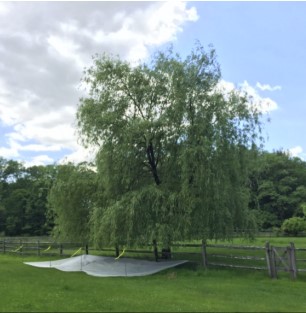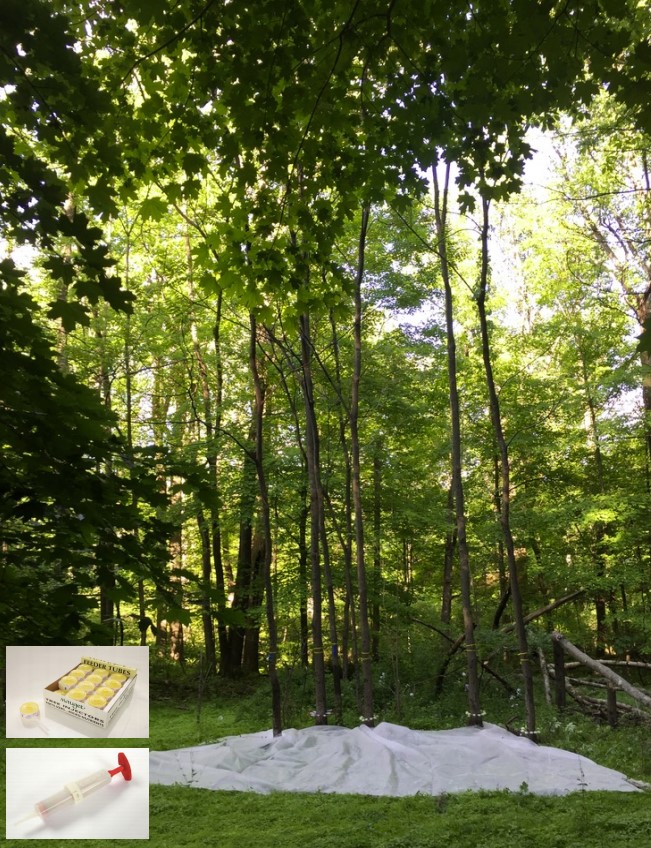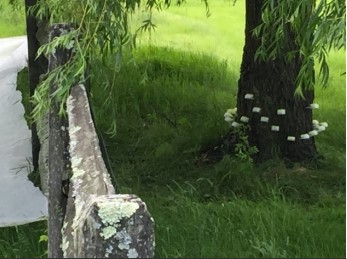
Tree injection delivery of systemic insecticide for SLF management study:
Directed trunk application has become standard practice for treating trees infested with SLF, and employed at the Rolling Rock Stone Quarry, 40 Rolling Rock Road, Boyertown, PA in Berks County.
Spotted Lanternfly- Preliminary Trial 1
Thick barked tree species of the genus Salix appear to be less adapted to accept directed trunk application. Our study hypothesis that the use of tree injection is more adept at providing management of SLF in this tree genera. Gary Weller, the owner of the quarry, provided two SLF infested weeping willow trees for a preliminary study to determine the efficacy of dinotefuran against newly emerging nymphs using the Mauget tree injection system.
Assessment of egg masses was made from counting egg masses on the underside of three accessible limbs and trunk of two willow trees. Tree 1 was >35’ in height, 12’ in circumference averaged 6.4 egg masses per limb, Tree 2 was <30’ in height, 10’ in circumference averaged 4.1 egg masses per limb.

Mauget Tree Injection system,
employing Mauget’s Dinocide™ to willow.
On the 25th April, approximately 2 weeks prior to SLF emergence in PA, using a portable electric drill and 11/64 in. (0.4 cm) drill bit, holes bored through bark and cambium were made. Using a soft-headed mallet, the Mauget tree injection system, employing the Dinocide formulation in Generation II capsules, were inserted 1” into the cambium at 3-4” spacing around the perimeter of each tree.
The capsules, containing 6 mL of dinotefuran in a 12% solution were pressurized to inject the solution into the wood to act as a systemic preventive application intended to kill emerging nymphs at the onset of emergence and feeding.
Collected overwintering eggs, stored in quarantine at 24°C, 75%rH and 14hr day length, emerged on 13 May signaled our travel to Boyertown to begin assessment of injection treatment on nymph populations. A 20’ x 40’ section of ‘No-See-Um’ netting (PAK Unlimited, Inc. Blockade™ Insect Screen 36 x 25 mils, Norcross, GA.) was secured beneath 40% of the tree canopy for a single tree to determine nymph mortality.
Nymphs mortality and those exhibiting climb and drop behavior were observed on the netting on 24 May.
During counts 97% mortality of nymphs (137) were found on the net with 5% moribund or slowly moving (7), with 3% of the nymphs (4) showing no signs of toxicity.
The surviving nymphs may simply represent those that climb and drop without feeding on willow branches. Exposure time may have been insufficient or delayed, or efficacy of the insecticide in the tree canopy may not have been evenly distributed. Ground water levels were amply to high and sunlight was available for several days for strong transpiration leading to cambium movement of the active ingredient into the branches where SLF nymphs feed. No SLF adults or overwintering eggs were observed the following fall in the two treated willow specimens.
Spotted Lanternfly- Preliminary Trial 2.
A second trial was attempted on 24th May along a woodland clearing employing a cluster of 9 young (<10 yr. old) Tree of Heaven, Ailanthus altissima (Image 1). Fresh egg masses were excised from maple trunks along with newly emerged 1st instar nymphs, laboratory reared on A.altissima and placed on trees treated using two different Mauget tree injection systems using reloading ChemJet injectors and prefilled capsules.
Generation II capsules and ChemJet containing 6 mL of dinotefuran in a 12% solution
are pressurized to inject the solution into the xylem wood, moving as a translaminar
systemic preventive application to deliver this tool to emerging nymphs at the onset of
emergence and feeding. Populations of emerging and hand placed SLF nymphs were
very low.


A. altissima with SLF egg (L) & nymph (R) 1st instar SLF on A. altissima bolt for transfer.
Very few nymphs were recovered from nets placed under injected trees and yellow
sticky tree wraps (not shown). As such, efficacy results could not be determined.

Image 1. Ailanthus altissima cluster treated with ChemJet (L) and pre-filled capsules (R).
The Hudson Valley Research Laboratory (HVRL Inc.) is a 501(c)(3), a non-profit organization whose mission is to conduct scientific
research and dynamic extension outreach to meet the needs of the agricultural industry.
